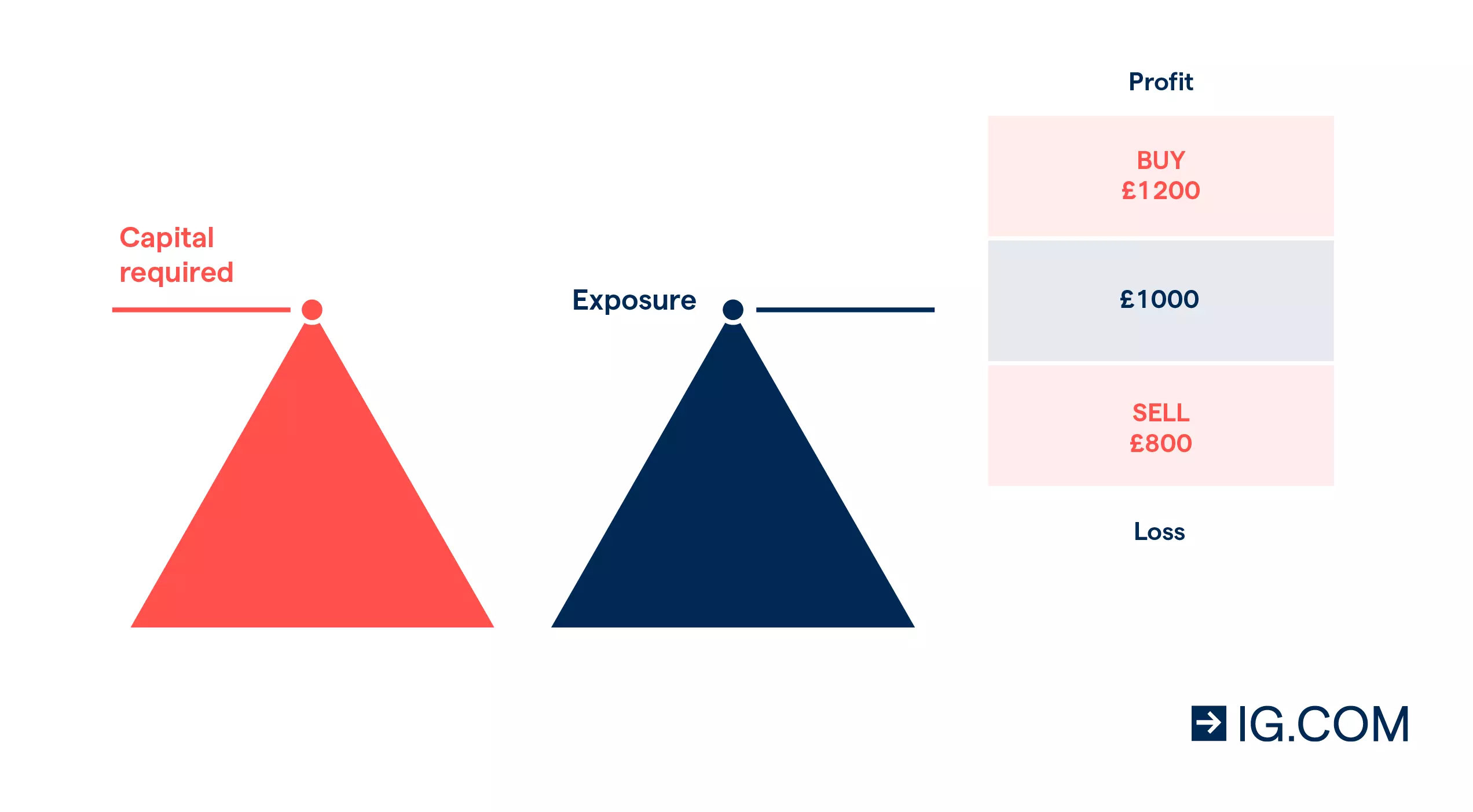What is leverage?
Leverage trading allows you to control larger market positions with smaller deposits than traditional trading. By amplifying your market exposure, leveraged products like CFDs can magnify both potential profits and losses, making risk management essential.

Leverage is a key feature of CFD trading, and can be a powerful tool for a trader. You can use it to take advantage of comparatively small price movements, ‘gear’ your portfolio for greater exposure, or to make your capital go further. Here’s a guide to making the most out of leverage – including how it works, when it’s used, and how to keep your risk in check.
How does leverage work?
Leverage trading works by amplifying your market exposure through borrowed capital. Using a deposit called margin, leverage trading allows you to control positions worth significantly more than your initial investment. Essentially, you're putting down a fraction of the full value of your trade – and your provider is loaning you the rest. Your total exposure compared to your margin is known as the leverage ratio.
Unleveraged vs leveraged trading:
With unleveraged products, you will need to commit the full value of your position upfront. For example, let’s say you want to buy 10 shares of a company at a share price of 100p each. To open a conventional unleveraged trade, you’d be required to pay this full value upfront (£1000).
This means more initial capital outlay but also caps your risk more than leveraged trading, as the risk of loss with unleveraged trading is equal to the amount paid to open the position. So, in our example, the potential for loss is also limited to the £1000 you paid for the position.
If the company’s share price goes up by 20p, your 1000 shares are now worth 120p each. If you close your position, then you’d have made a £200 profit from your original £1000. If the market had gone the other way and shares of the company had fallen by 20p, you would have lost £200, or a fifth of what you paid for the shares.
Or you could have opened your trade with a leveraged provider, who might have a margin requirement of 10% on the same shares.
Here, you’d only have to pay 10% of your £1000 exposure, or £100, to open the position. If the company’s share price rises to 120p, you’d still make the same profit of £200, but at a considerably reduced cost.
If the shares had fallen by 20p then you would have lost £200, which is twice your initial deposit.
It's important to note that while leverage can amplify your profits, it'll also amplify your losses, so it's vital to take steps to manage your risk.
Unleveraged

Leveraged

Leveraged products
The majority of leveraged trading uses derivative products, meaning you trade an instrument that takes its value from the price of the underlying asset, rather than owning the asset itself.
Our main leveraged product is:
An agreement with a provider (like us) to exchange the difference in price of a particular financial product between the time the position is opened and when it is closed.
Which markets can you trade using leverage?
Some of the markets you can trade using leverage are:
- Shares
A share is a unit of ownership for a particular company, and is usually bought and sold on a stock exchange. You can use leveraged products to open positions on thousands of shares, from blue chips like Apple and Facebook, to penny stocks. - Indices
An index is a numerical representation of the performance of a group of assets from a particular exchange, area, region or sector. As indices are not physical assets, they can only be traded via products that mirror their price movements – including CFD trading and ETFs. - Forex
Foreign exchange, or forex, is the buying and selling of currencies with the aim of making a profit. It is the most-traded financial market in the world. The relatively small movements involved in forex trading mean that many choose to trade using leverage. - Commodities
Choose from over 35 commodities when you trade with us, including gold, oil and silver.
When researching leveraged trading providers, you might come across higher leverage ratios – but be aware, using excessive leverage can have a negative impact on your positions.
Benefits and risks of using leverage
Provided you understand how leveraged trading works, it can be an extremely powerful trading tool.
Benefits of using leverage
- Magnified profits. You only have to put down a fraction of the value of your trade to receive the same profit as in a conventional trade. As profits are calculated using the full value of your position, margins can multiply your returns on successful trades – but also your losses on unsuccessful ones.
See an example of magnified profit - Gearing opportunities. Using leverage can free up capital that can be committed to other investments. The ability to increase the amount available for investment is known as gearing.
- Shorting the market. Using leveraged products to speculate on market movements enables you to benefit from markets that are falling, as well as those that are rising – this is known as going short.
- 24-hour dealing. Though trading hours vary from market to market, certain markets – including key indices and forex markets – are available to trade around the clock.
Drawbacks of using leverage
Though CFDs and other leveraged products provide traders with a range of benefits, it is important to consider the potential downside of using such products as well. Here are a few key things to consider:
- Magnified Losses. Margins magnify losses as well as profits, and because your initial outlay is comparatively smaller than conventional trades, it is easy to forget the amount of capital you are placing at risk. You won’t be able to lose more than the balance on your account, but you should always consider your trade in terms of its full value and downside potential – and take steps to manage your risk.
- No shareholder privileges. When trading with leverage you give up the benefit of actually taking ownership of the asset. For instance, using leveraged products can have implications on dividend payments. Instead of receiving a dividend, the amount will usually be added or subtracted to your account, depending on whether your position is long or short.
- Margin calls. If your position moves against you, your provider may ask you to put up additional funds in order to keep your trade open. This is known as margin call, and you’ll either need to add capital or exit positions to reduce your total exposure.
- Funding charges. When using leverage you are effectively being lent the money to open the full position at the cost of your deposit. If you want to keep your position open overnight you will be charged a small fee to cover the costs of doing so.
Leverage and risk management
Leveraged trading can be risky as losses may exceed your initial outlay, but there are numerous risk-management tools that can be used to reduce your potential loss, including:
Stops
Attaching a stop to your position can restrict your losses if a price moves against you. However, markets move quickly and certain conditions may result in your stop not being triggered at the price you’ve set.
Guaranteed Stops
These work in the same way as basic stops, but will always be filled at exactly the level you’ve set, even if gapping or slippage occurs. If your stop is triggered, there will be a small premium to pay in addition to normal transaction fees.
Using stops is a popular way to reduce the risk of leverage, but there are numerous other tools available – including price alerts and limit orders.
What is leverage ratio?
Leverage ratio is a measurement of your trade’s total exposure compared to its margin requirement. Your leverage ratio will vary, depending on the market you are trading, who you are trading it with, and the size of your position.
Using the example from earlier, a 10% margin would provide the same exposure as a £1000 investment with just £100 margin. This gives a leverage ratio of 10:1.
Often the more volatile or less liquid an underlying market, the lower the leverage on offer in order to protect your position from rapid price movements. On the other hand, extremely liquid markets, such as forex, can have particularly high leverage ratios.
Here’s how different degrees of leverage affect your exposure (and thus profit potential and maximum loss) for an initial investment of £1000:
| Unleveraged trading | Leveraged trading | ||||
| 1:1 | 20:1 | 50:1 | 100:1 | 200:1 | |
| Outlay | £1000 | £1000 | £1000 | £1000 | £1000 |
| Exposure | £1000 | £20,000 | £50,000 | £100,000 | £200,000 |
